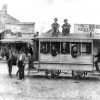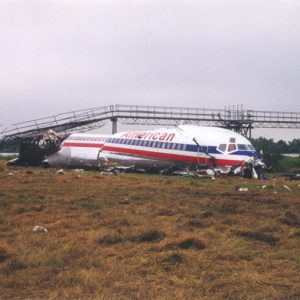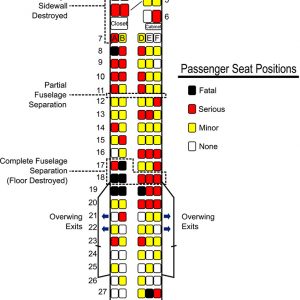calsfoundation@cals.org
American Airlines Flight 1420
American Airlines Flight 1420 departed Dallas/Fort Worth International Airport on June 1, 1999, en route to what is now Bill and Hillary Clinton National Airport in Little Rock (Pulaski County). As the aircraft landed, it ran off the end of the runway and broke apart. Ten passengers and the pilot died in the crash or from injuries suffered in the event.
The aircraft involved in the crash was a McDonnell Douglas MD-82. At the time of the incident, the plane had 49,136 flight hours and 27,103 cycles (take-offs and landings). On the aircraft at the time of the crash were two flight crew members, four flight attendants, and 139 passengers.
The flight originated in Chicago, Illinois, flying to Salt Lake City, Utah, before flying to Dallas/Fort Worth. The flight landed in Dallas thirty-nine minutes behind schedule due to a weather delay on the approach into DFW. The plane landed at 8:10 p.m. and the flight to Little Rock was scheduled to depart at 8:28. This departure was initially pushed back to 9:00. The flight crew planned to use another aircraft for the flight to Little Rock, but it was delayed due to the weather, and so the MD-82 was selected for the flight. The flight crew could not take off after 11:16 p.m., as doing so would put them over the daily maximum number of flying hours. The plane finally departed for Little Rock at 10:40 p.m.
At 10:54, the crew received a message from the flight dispatcher that the weather around Little Rock might impact the arrival. Diversionary airports for the flight were Nashville, Tennessee, and Dallas/Fort Worth. Speaking with Little Rock Air Traffic Control at 11:34, the pilots were informed of a thunderstorm northwest of the airport with wind measuring at twenty-eight knots and gusts up to forty-four knots. In a post-crash interview with the co-pilot, he mentioned that the two pilots discussed the storm and agreed that they had time to land and beat the approaching storm.
The storm made it difficult for the aircrew to clearly see the airport. Originally set to land on runway 22L, the aircrew requested to land on runway 4R instead, which would allow the aircraft to land with a headwind instead of a tailwind. As the aircraft approached the airport, visibility continued to decrease, and the co-pilot later reported that he thought they would go around for another approach before landing. The flight crew performed some but not all of the steps on the landing checklist. The auto spoiler, which is designed to slow an aircraft, was not armed and thus did not automatically deploy upon landing. The plane touched down at 11:50 p.m., and the first officer stated that the aircraft was sliding. The pilots deployed reverse thrusters and repeatedly deployed the brakes in an effort to stop the plane. The flight crew lost control of the aircraft, and it slid down the runway.
The plane continued to slide out of control over more than 800 feet of grass and struck an instrument landing system (ILS) array. Continuing forward, the aircraft crashed through a chain-link fence, went over a rock embankment, and came to rest next to the Arkansas River, about fifteen feet below the runway.
The plane had struck a lighting array, causing extensive damage, and had broken into three major pieces, with the front of the fuselage at a ninety-degree angle, facing southeast, while the rest of the aircraft turned roughly 180 degrees and faced the runway. The front and center sections had been roughly separated from the rest of the aircraft by the lighting array.
The passengers and crew began to evacuate the aircraft via any means of escape, with many going through holes in the fuselage. A fire in the center and rear portions of the fuselage erupted. The survivors encountered heavy rain, strong winds, and hail, with some reportedly taking cover among hay bales.
The Aircraft Rescue and Fire Fighting Division of the Little Rock Fire Department responded to the crash after a call was placed to the division at 11:52 p.m. and left the station within one minute of the call. The weather, along with confusion about the exact location of the aircraft, led to the crash being discovered at 12:01 a.m. when firefighters saw the burning plane in the distance. Unable to directly approach the aircraft due to lower elevation at the end of the runway, the trucks had to backtrack to an access road and approach the crash. The trucks arrived at 12:08 and worked to extinguish the fire while assisting survivors. Additional rescue units from the Little Rock Fire Department and Metropolitan Emergency Medical Services arrived. Four survivors were airlifted to hospitals.
Multiple hospitals treated survivors, including Arkansas Children’s Hospital, Arkansas Heart Hospital, Baptist Medical Center, St. Vincent Hospital, and the University of Arkansas for Medical Sciences (UAMS) Medical Center.
A total of ten passengers and one crew member died as a result of the crash. Captain Richard Buschmann, the pilot of the aircraft, was killed. Eight passengers died in the crash or immediately afterward, including residents of Havana (Yell County), Russellville (Pope County), and Paragould (Greene County). One passenger died on June 10, and Rachel Fuller of Arkadelphia (Clark County) died on June 16 from injuries sustained in the crash. The Ouachita Singers, a performance group from Ouachita Baptist University (OBU), were on the flight returning from a trip to Europe. Fuller, a student at Arkadelphia High School, was the daughter of the group’s director and accompanist.
Dedicated on April 10, 2007, the Rachel Fuller and Ouachita Singers Memorial Amphitheater is located on the campus of OBU in Arkadelphia. The Flight 1420 Memorial is located in Little Rock south of the airport on East Roosevelt Road near the Business and Industry Center of the University of Arkansas–Pulaski Technical College. A park in Russellville memorializing the six city residents killed in the crash was dedicated in 2001.
For additional information:
Green, Andrew, and Kim McGuire. “1420’s Fatal Flight.” Arkansas Democrat-Gazette, June 3, 1999, pp. 1A, 10A.
Harter, Andrea. “Flaps Failed, Official Says.” Arkansas Democrat-Gazette, June 4, 1999, pp. 1A, 6A.
———. “Russellville Park Memorializes 6 Killed in Crash.” Arkansas Democrat-Gazette, June 2, 2001. https://www.arkansasonline.com/news/2001/jun/02/russellville-park-memorializes-6-killed-crash/ (accessed October 10, 2024).
“Jetliner Crashes in LR.” Arkansas Democrat-Gazette, June 2, 1999, pp. 1A, 7A.
Merryman, Jon. “Alumni profile: Flight 1420 Crash.” Ouachita Stories, Ouachita Baptist University, February 27, 2020. https://obu.edu/stories/circle/2020-winter/alumni-profile-flight-1420-crash.php (accessed October 9, 2024).
National Transportation Safety Board. “AIRCRAFT ACCIDENT REPORT PB2001-910402 NTSB/AAR-01/02 DCA99MA060 RUNWAY OVERRUN DURING LANDING AMERICAN AIRLINES FLIGHT 1420 MCDONNELL DOUGLAS MD-82, N215AA LITTLE ROCK, ARKANSAS JUNE 1, 1999.” https://www.ntsb.gov/investigations/AccidentReports/Reports/AAR0102.pdf (accessed October 9, 2024).
David Sesser
Southeastern Louisiana University










Comments
No comments on this entry yet.